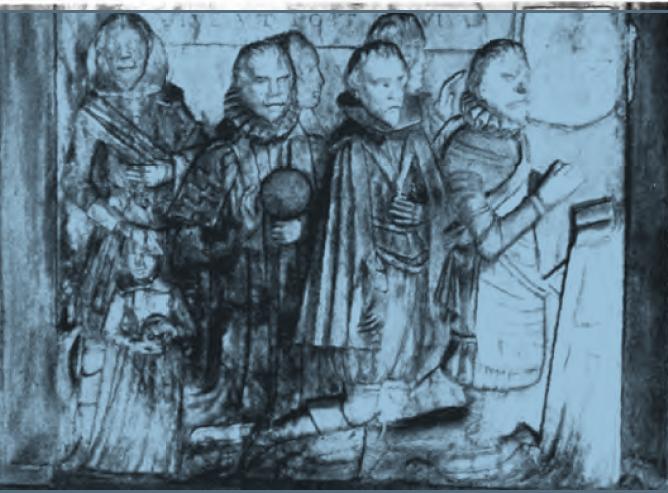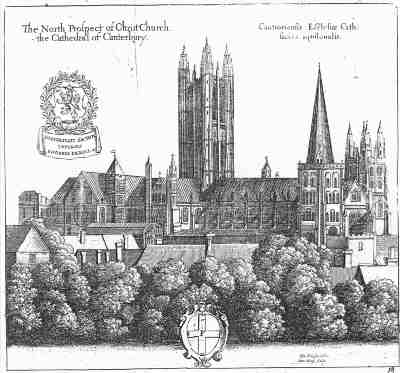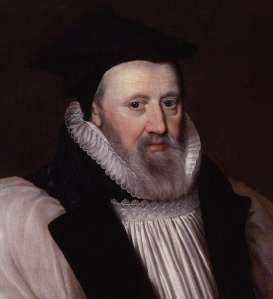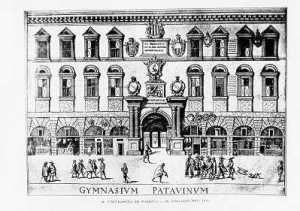The lack of activity on this site since January reflects the fact that I’d reached something of a dead end in my exploration of the Langworth family and their recusant connections. To date, I’ve been unable to find any evidence of recusant activity in the life of Francis Langworth (1597 – 1688), youngest son of Dr John Langworth (1547 – 1614), despite the fact that he married into the Catholic Darell family of Calehill, Kent. Two of Francis’ sisters, Mary and Helen, married known recusants.
However, my interest in the Langworths has been re-awakened by some new information sent to me by Emily Buffey, the doctoral researcher in English Literature whose original email first sparked my curiosity about the family. Emily has come across a reference to Dr John Langworth in a book about the ‘trial’ of John Howson before James I, which took place at Greenwich on 10th June 1615. Howson, a prominent cleric, was accused of ‘popery’ by the Archbishop of Canterbury, George Abbot (1562 – 1633), a noted Calvinist. Howson’s answers to Abbot’s accusations were enough to convince the King that the charges were misplaced and to save his clerical career: he went on to become Bishop of Oxford and then Bishop of Durham.
The extract from the collection of Howson’s answers to Abbott, edited by Nicholas Cranfield and Kenneth Fincham, describes John Langworth as ‘a friend of Carier’. Benjamin Carier or Carrier (1566 – 1614) was a fellow of Corpus Christi College, Cambridge, chaplain to Archbishop John Whitgift and also to King James. Interestingly, Carrier was born in Kent and served as rector of Old Romney and then as a Prebendary of Canterbury in 1608. John Langworth was also a Prebendary at Canterbury Cathedral until his death in 1614. Benjamin Carrier travelled abroad some time in the early 1610s, ostensibly for the benefit of his health, but in reality to make contact with exiled Catholics and to be received into the Church, on whose behalf he then proceeded to write a series of polemical works. It was partly Carrier’s conversion that placed John Howson, another good friend of his, under suspicion. One can imagine a similar shadow being cast over his Canterbury colleague John Langworth.
Cranfield and Fincham quote from a letter of 16th March 1613 from Archbishop Abbott to the diplomat Dudley Carleton (1573 – 1632), in which he writes:
You wrote unto mee once concerning two Lungworths [sic], whose father was a greate Papist, althought a Dr. of Divinity. Hee was a notable Hypocrite, and a man suspected all his time, but went to Churche, and received the Communion. His second sonne called Arthur is lately dead at Padua, as I am informed. But the other brother is come home, and for his demerith abrode lyeth now in the Gatehouse.
This is intriguing, not only for confirmation of the suspicion that Dr John Langworth was a ‘church papist’, but also for the information about his sons. Sources seem to disagree about the number and names of John Langworth’s children. According to the pedigree in the Visitation of Kent of 1619, John and his wife Frances only had two sons, Thomas being the eldest and Francis the second, as well as four daughters: Mary, Anne, Helen and Martha. In his will of 1613, or at least in the summary version available online, Langworth mentions three sons: ‘my youngest son Francis Langworth’, ‘Arthur my second son’ and ‘my son John’. However, a note below this summary lists John Langworth’s children as Thomas, Arthur, John, Anthony, Francis, Mary, Helen and Martha.
The identity of the ‘other brother’ mentioned by Archbishop Abbott remains a mystery: was it Thomas, who married Margaret Clerke, daughter of Joseph Clerke of Surrey, or does his absence from his father’s will mean that he did not survive him? Or was it Francis? Presumably the ‘Gatehouse’ is the building of that name in Canterbury, which served as a prison. Further research will be needed to solve this mystery, but for now the most interesting thing about Abbott’s letter is the reference to the brothers’ absence abroad, and specifically to Padua. Did two of John Langworth’s sons follow the example of their father’s friend, Benjamin Carrier, and go abroad to make contact with Catholic exiles?
As I’ve noted before, the university at Padua seems to have been a popular destination for English Catholic students seeking to avoid taking the Oath of Allegiance, which attendance at Oxford or Cambridge would have required of them. John Hawkins, the recusant physician and writer who was the brother-in-law of John Langworth’s daughter Mary, studied medicine there, as did John Kirton, nephew of John Hawkins’ brother Thomas.
This new information suggests that at least two of John Langworth’s sons were active recusants, rather than simply ‘church papists’ like their father. As for John himself, it seems that his Catholic sympathies emerged into the open at the very end of his life. Cranfield and Fincham note: ‘Catholic newsletters disclose that a Roman priest attended Langworth on his deathbed, although he was not received into the Catholic Communion.’




I want to thank you for your hard word. Mary Darell Tucker and George Darell are my 9th great-grandparents, and Francis Langworth is there son. Oddly, Mary’s father John Darell is also my 9th Great-grandfather, through his son James, my 8th great-grandfather through a different line (the Darells and the Tuckers intermarried several times), especially when they all lived in Bermuda. John Darell’s wife Anne Horne’s father was the well-known Bishop Horne. The Darell family also intermarried with the Richard Rich family. The Darrells, Riches, and Tuckers were all involved with colonial Bermuda and Virginia and owned land in Bermuda. It’s interesting that Richard Rich, Thomas Darell of Scotney, and Thomas Cromwell all worked to dissolve the monasteries and with the Court of Augmentations, and I’m descended from all of them.
LikeLike
Dear Ed, Thank you for your comment and for this really interesting information about the Darrells. Apologies for the long delay in replying: I’m afraid I’ve neglected this blog over the past few years. Best wishes, Martin
LikeLike